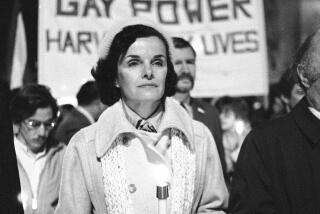Paul Nitze, 97; Key Player in U.S. Foreign Policy During Cold War
- Share via
Paul Nitze, who played a pivotal role in shaping U.S. foreign and arms control strategy from the 1940s through the end of the Cold War, has died. He was 97.
Nitze died of pneumonia Tuesday night at his home in the Georgetown section of Washington, D.C., according to his son, William.
Nitze, a dashing East Coast aristocrat sometimes referred to as “the silver fox,” first entered public service in Franklin D. Roosevelt’s presidency and retired six decades later at the start of the first Bush administration. He was among a small group of patricians that included Dean Acheson, W. Averill Harriman, John McCloy, Robert A. Lovett, George F. Kennan and Charles E. (Chip) Bohlen who influenced nearly every major national security decision from World War II through the Korean and Vietnam wars.
It was Nitze who drafted a document that first laid out the military framework for containing the Soviets, which put in place the Cold War strategy in effect until the Soviet Union collapsed in 1991 and the arms race subsided.
He held a number of official titles in the State and Defense departments and was secretary of the Navy from 1963 to 1967. But even when not an official part of any administration, he was at the center of power, cajoling, criticizing, shaping and commenting.
“Wise men come and wise men go, but decade after decade there is Paul Nitze,” President Reagan’s Secretary of State George P. Shultz said on the occasion of Nitze’s 80th birthday, two years before Nitze stepped out of the public spotlight.
Nitze’s list of accomplishments includes helping to assess the effects of bombing during World War II, including the atomic bombs dropped on Japan, and helping to formulate the Marshall Plan that rescued postwar Europe from economic devastation.
In 1960, Nitze was brought on board by John F. Kennedy, first as an advisor to the Democratic presidential candidate on national defense and later as a member of the president’s “ExCom,” the small group of strategists and advisors who counseled JFK during the Cuban missile crisis.
In the Nixon administration, Nitze played a key role in negotiating the SALT I antiballistic missile treaty.
And during the Reagan administration, Nitze’s “walk in the woods” with Soviet negotiator Yuli Kvitsinsky became one of the most legendary (if failed) negotiations of the Cold War, inspiring a Broadway play by the same name.
Finally, in his 70s and 80s, he became the gray eminence of arms control negotiations. Even those who shunned him, as President Carter did after finding him “arrogant and inflexible,” were forced to reckon with him.
In May 2002, President George W. Bush’s national security advisor, Condoleezza Rice, in welcoming Nitze to a Washington, D.C., event, honored him for his “visionary work in containing the Soviet Union.”
In April, a warship bearing his name was christened in Bath, Maine.
Paul Henry Nitze -- he claimed his family name stemmed from the same Sanskrit word as the Greek word nike, or victory -- was born Jan. 16, 1907, in Amherst, Mass. His father was William Albert Nitze, a philologist and professor of Romance languages at Amherst College who later taught at the University of Chicago. His mother, Anina, was a woman of “immense vitality, warmth, wit and energy,” Nitze once wrote, but she shocked her husband’s university friends by smoking, speaking her mind and forming friendships with fan dancer Sally Rand and lawyer Clarence Darrow.
By the age of 12, Nitze observed that his father and other academics were “powerless to influence” the troubling events of the time. He wanted to be closer to the levers of influence.
All the stars -- family, education, marriage into wealth, ambition, excellent connections, longevity and a hearty constitution -- would align to help him reach that goal.
At Harvard University, where he got a degree in economics and finance, he found his lifelong social milieu as a member of the elite (and rowdy) Porcellian Club, of which Teddy Roosevelt had been a member and from which FDR had been blackballed.
In early October 1929, Nitze took a job as an investment banker on Wall Street for Dillon, Read & Co. When Black Thursday hit on the 29th of that month, opening the door to the Depression, the young Nitze survived the firm’s drastic cutbacks. There, he made friends with James Forrestal, who would later bring Nitze into FDR’s administration.
In 1932, in another stroke of good luck, Nitze married Phyllis Pratt, a Standard Oil Co. of New York heiress whose enormous wealth liberated him to follow his own interests.
It was a family vacation in 1937 to Germany, then under the rule of Adolf Hitler, that started Nitze thinking beyond the world of investment banking. Returning to the U.S., Nitze became fascinated with Oswald Spengler’s “The Decline of the West,” which saw human history as a repetition of the growth, flowering and decay of civilizations.
He quit Dillon, Read to return to Harvard to try to understand Spengler and the changes overtaking the world in the late 1930s. While at Harvard, he decided he needed a better way than academia to influence the course of history.
After a brief return to Wall Street, he accepted Forrestal’s invitation to be his aide as Forrestal took his place as a top assistant in the Roosevelt administration. The old firm continued to pay Nitze’s salary, which was “all totally illegal and improper,” Nitze would jovially recount in later years.
Nitze’s first paid government job was for Nelson Rockefeller as finance director of the Office of Inter-American Affairs. When World War II ended in 1945, Nitze was sent by Truman to help with the “strategic bombing survey.”
As part of that responsibility, Nitze went to ground zero in Hiroshima and Nagasaki, the two cities hit by U.S. atomic bombs to bring the war to the close. Nitze told a journalist in 1979 that after that experience, he “spent a large percentage of my time worrying about the posture the U.S. should take in light of this dreadful fact, the existence of nuclear weapons.”
Nitze’s next postwar duty was among a small group of policymakers, including Kennan of the State Department, who recognized that the first step after World War II must be to restore prosperity and economic health to Europe. They devised the “Marshall Plan,” named for Secretary of State George C. Marshall, to rescue the Continent.
To forward the ambitious plan in Congress, Nitze became one of the Truman administration’s leading experts on the European economy and the one to whom fell the task of justifying each of the 16 countries’ requests for aid. To do the math, Nitze biographer David Callahan wrote in 1990, Nitze borrowed all the calculating machines of the Prudential Life Insurance Co. in Newark, N.J.
It was during the immediate postwar period that Nitze began to fear that Western weakness would lead to the dominance of a World War II ally that some were beginning to feel could quickly turn into an enemy: Stalin’s Soviet Union. From then on, as Nitze biographer Strobe Talbott wrote, “Much of his life has been a Paul Revere’s ride to alert America that the Russians are coming.”
Nitze’s fears at first were dismissed by then-Under Secretary of State Acheson, who accused him of “just seeing mirages.” But when Truman ordered a strategic review, Acheson oversaw Nitze’s drafting of National Security Council document No. 68. In it, Nitze used strong language in declaring the Soviet Union as “animated by a new fanatic faith” and said it “seeks to impose its absolute authority over the rest of the world.” The Marshall Plan and NATO fell far short of being able to meet this challenge, Nitze believed.
At first reluctant to believe Nitze’s apocalyptic view, soon Truman and the Congress were on board, and the arms race was on. Within a short time, the U.S. defense budget had quadrupled. National Security Council document No. 68 became such a keystone of Cold War military policy that it was referred to by policymakers simply as NSC 68.
A few years later, Nitze wrote a report that outlined major gaps -- first in bombers and later in missiles -- in U.S. defenses. The so-called Gaither report was named after H. Rowan Gaither, who was chairman of the committee that President Eisenhower appointed to study how the nation’s strategic nuclear force ought to be structured.
Around this time, Nitze switched parties, from Republican to Democrat. As Nitze later lamented, his equivocal partisanship probably cost him an appointment to the highest political offices.
In 1960, Nitze became an advisor to presidential candidate Kennedy on national defense issues. After Kennedy’s election, Nitze was appointed assistant secretary of Defense for international security affairs.
During the 1962 Cuban missile crisis, Nitze was a member of Kennedy’s small group of Cabinet members and advisors who counseled the president when Nikita Khrushchev threatened to place missiles in Cuba, which brought the U.S. and the Soviet Union to the brink of nuclear war. Nitze believed that having missiles within minutes of the U.S. would allow the Soviet Union to hold “a pistol at America’s head” and that the U.S. must stop, by whatever means, the missiles from being put in place.
At the time, Nitze was one of the junior members of the group.
“But his tone in the meetings was that of a stern elder, stiffening the backbone of the young president,” Talbott wrote.
Kennedy nominated Nitze for secretary of the Navy, a post he held until 1967, when he became deputy secretary of Defense. After that, he turned to arms negotiations.
In 1972, under President Nixon, Nitze negotiated the SALT I antiballistic missile treaty, but he quit the SALT II negotiations to limit offensive weapons because he feared that Nixon, anxious to divert attention from Watergate, was giving away too much to the Soviets.
Later, when Jimmy Carter was elected president and refused to put Nitze on the arms control team, Nitze led the opposition to the SALT II treaty, which some interpreted as an act of revenge. Nitze maintained that he opposed SALT II because he believed it would have assured “a strategic nuclear capability superior to our own.” Nitze, who had formed the Committee on the Present Danger in 1976, the year Carter was elected, traveled coast to coast to denounce SALT II as a threat to U.S. security.
Carter’s successor, Ronald Reagan, opened the door once again to Nitze’s arms control experience. It was in service to Reagan that Nitze took the famed “walk in the woods,” fictionalized in Lee Blessing’s two-character Broadway play. The episode perhaps best illustrates Nitze’s abilities as an arms negotiator as well as the arrogance that at times made him controversial.
It was 1982, and Nitze was the leader of the U.S. delegation to the intermediate-range nuclear forces negotiations in Geneva. Kvitsinsky was his counterpart. Both sides were publicly positioned at a point where no agreement seemed possible. Then the two experienced negotiators, who had become acquainted in earlier meetings, decided to meet informally, away from Geneva.
They took a route through mountain passages to a spot near the town of Saint-Cergue, overlooking Geneva, and left their driver behind to walk along a country road through mountain pastures.
Soon they were engrossed in a “what if?” conversation. Nitze had prepared four “papers,” which he pulled out of his pocket one by one. Paper A said in part: “If Moscow is adamant in wishing a one-sided deal ... there is no point.”
Kvitsinsky read this and “understood it,” Nitze later wrote.
“By now we were sitting side by side on the top of a pile of felled trees on the edge of the logging road,” Nitze said. He gave Kvitsinsky papers B and C, which were progressively more detailed. The final memo, Paper D, outlined in 15 points the elements of a possible compromise, including such specifics as “there will be no increase in the present aggregate number of the SS-12/22 and SS-23 missile systems ... .”
The two men argued about some numbers. Then it began to rain, and they ran back to the waiting Mercedes-Benz to finish their discussion before returning to Geneva.
But now on the table for their two countries was a previously almost inconceivable idea: a formula for balancing the numbers of Soviet SS-20 missiles against a similar arsenal of U.S. cruise missiles stationed on the European continent.
“I had that internal glow that comes from having done something truly constructive,” Nitze wrote of this meeting.
The glow didn’t last long. Both sides eventually rejected the proposal, and Nitze was the brunt of harsh criticism for having exceeded his authority.
Nitze told National Public Radio’s Terry Gross in 1989, “I still believe it would have been a very good deal for us, and a very good deal for the Soviets, and a lot of pain and agony would have been avoided if that had been approved by both sides.”
By 1983, he was back in the thick of arms talks, including one more walk with Kvitsinsky -- this one dubbed “a walk in the park.”
Ironically, Nitze, who had been viewed by President Carter as the intellectual leader of the hawks, was seen by some in the Reagan administration as a dove who was perhaps too enthusiastically bent on treaty-making.
Nitze was also involved in the 1984-85 START (strategic arms reduction talks) negotiations and the 1986 arms summit in Reykjavik, Iceland, during which he stayed up all night with a Soviet counterpart to establish the first numbers and counting rules for strategic arms reduction.
And when Reagan and Soviet leader Mikhail Gorbachev met in 1987 in Washington to sign the intermediate-range nuclear forces (INF) treaty, Nitze was again on hand to warn, “We must not forget that the devil often lurks in the details.”
Public policy wasn’t all there was to Nitze. He learned to play the piano as an adult, fascinated especially by Bach. He was an avid tennis player and skier well into his later years. And he was a successful businessman; one particularly successful venture, which he embarked on with his sister, Elizabeth “Pussy” Paepcke, was a substantial investment in an abandoned 19th century mining town in Colorado. The development of Aspen helped make skiing the popular American sport that it has became.
The School of Advanced International Studies at Johns Hopkins University, which he helped found, now bears Nitze’s name. In 1985, Reagan awarded him the Presidential Medal of Freedom, the highest civilian honor in the United States.
Nitze’s first wife died in 1987. Besides his son, William, and three other children from his first marriage, Heidi, Peter and Phyllis Anina, survivors include his second wife, Leezee Porter; 11 grandchildren, and seven great-grandchildren.
A funeral service will be held Saturday at the National Cathedral in Washington.
More to Read
Sign up for Essential California
The most important California stories and recommendations in your inbox every morning.
You may occasionally receive promotional content from the Los Angeles Times.













